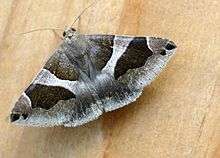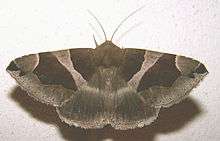Dysgonia algira
Dysgonia algira, the passenger, is a moth of the family Noctuidae. The species was first described by Carl Linnaeus in 1767 and is found in the Palearctic -the range extends from Spain and Morocco in the west to southern Europe and North Africa , Asia Minor , southern Russia to Iran , Afghanistan , Turkmenistan and Kyrgyzstan . In the north the range extends to the west of France and as far as southern Germany , eastern Austria ( Burgenland , Lower Austria ) and Hungary . In the Southern Alps it is found up to 700 meters.
| Dysgonia algira | |
|---|---|
 | |
 | |
| Scientific classification | |
| Kingdom: | |
| Phylum: | |
| Class: | |
| Order: | |
| Family: | |
| Genus: | |
| Species: | D. algira |
| Binomial name | |
| Dysgonia algira (Linnaeus, 1767) | |
| Synonyms | |
|
List
| |
Technical description and variation
O. algira L. (= achatina Sulz., triangularis Hbn) Forewing brownish fuscous, with a purplish tinge when fresh; a whitish median band narrowed in middle, edged inwardly by the erect but slightly outcurved inner line, outwardly by the similarly incurved median line: outer line acutely angled outwards on vein 6 and bluntly bent between veins 3 and 4. then sinuous to inner margin near median line; a black apical streak of two spots; the terminal area violet grey: hindwing fuscous, with a diffuse whitish median band: the terminal area grey at middle: fringe grey, below apex whitish; the ab. mandschuriana Stgr.[ now full species Dysgonia mandschuriana (Staudinger, 1892) ] is more uniformly purplish or slaty grey, with the median band only slightly paler, not white. Larva yellowish grey, darker on dorsum, with tine black longitudinal lines; venter and feet pale grey; spiracles black; head yellowish grey.[1]The wingspan is 40–46 mm.
Biology
The moth flies from May to August depending on the location. The larvae feed on Rubus and willow.
References
- Warren. W. in Seitz, A. Ed., 1914 Die Großschmetterlinge der Erde, Verlag Alfred Kernen, Stuttgart Band 3: Abt. 1, Die Großschmetterlinge des palaearktischen Faunengebietes, Die palaearktischen eulenartigen Nachtfalter, 1914

External links

- Passenger on UKMoths
- Lepiforum e.V.